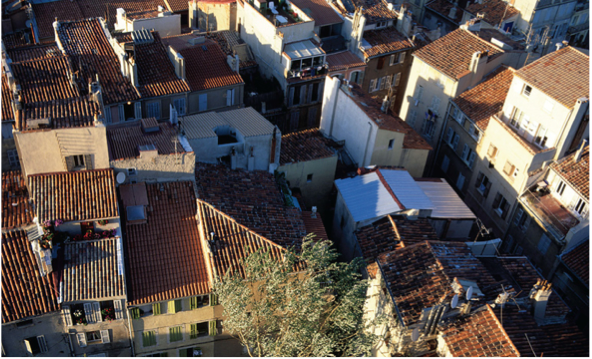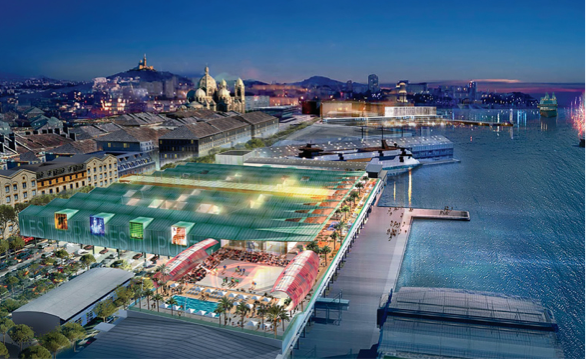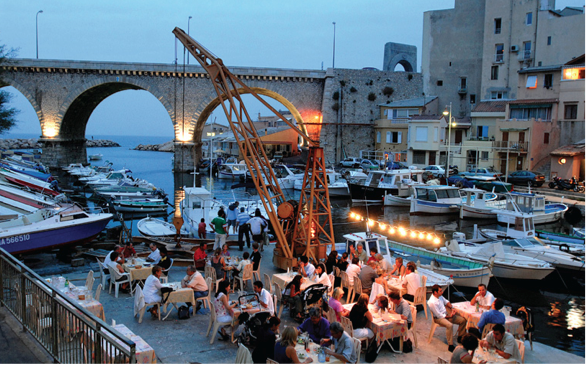France Magazine
Marvelous Marseille
Barely three hours after leaving Paris, the TGV hurtles past white rock and scrubby greenery beneath an impossibly blue sky, enters a tunnel under the mountains and rockets out the other end to a vision of the sparkling blue Mediterranean and the crazy patchwork of rooftops that is Marseille.
Massalia, as the Greeks called it, has all the gritty charm of a port city, and a Latin one to boot. Cradled between the mountains and the Med, it’s the country’s second-largest metropolis, a sprawling beast with a surface area two and a half times that of Paris but a population of fewer than a million. Throughout the 19th and early 20th centuries, it was the gateway to the French colonial empire, booming with maritime trade and industrial growth.
But the loss of France’s colonies and the activity they generated ushered in decades of economic decline. Absorbing massive immigration from the former North African colonies put an enormous strain on the city, which was then hit by the 1970s oil shocks and ensuing recession. Marseille became plagued by corruption and mismanagement, and by the 1980s, unemployment was a dizzying 25 percent.
That figure now stands at 12 percent, a reversal emblematic of the dramatic changes that have swept over this city in recent years. Many observers attribute the turnabout to sheer political will, a decision by the powers that be that enough was enough.
“Marseille used to have a very insular mentality, cut off from the rest of France,” explains François Tonneau, journalist at the local newspaper La Provence. That attitude started to change following the 1995 election of the current mayor, Jean-Claude Gaudin. Born and bred in Marseille, Gaudin is also a member of the Senate and close to the movers and shakers in Paris. He has used his office to garner state and regional support for local projects and to attract private investment, convincing companies to stay while encouraging new ones to move in, notably hi-tech industries such as telecommunications.
Visitors get a sense of this new Marseille the moment they arrive at the Saint Charles train station. Dating from the 19th century, it has been renovated and expanded, becoming a sleek and airy terminus for the TGV Med that links Paris to this sun-kissed city just in time for lunch. When the line was inaugurated in 2001, the impact was immediate: The distance between the two cities felt like a day trip, and residents of both started jumping on the train without a second thought.
At the same time, low-cost airlines profiting from Europe’s Open Skies treaty linked Marseille to northern Europe for the price of a bowl of bouillabaisse, and a new terminal for those flights, MP2, opened at the end of 2006. Simultaneously, city tourism officials started courting the cruise ship business, increasing passenger traffic from 19,000 in the mid 1990s to 440,000 today.
All of these factors have helped boost the number of visitors from 2.7 million to 4 million during the past decade. Construction is under way to add 1,600 hotel rooms to a city that was unprepared for such sudden popularity. In a sign of the times, the number of four-star rooms will double, the Sofitel has just spent €7 million on a luxurious makeover, and in 2011, the city is slated to get its first palace hotel, set in the historic Hôtel Dieu overlooking the Vieux Port.

Never known as a gastronomic capital, Marseille now boasts a burgeoning restaurant scene, attracting visitors with young, creative chefs such as Arnaud de Grammont at Le Café des Epices as well as established names such as Gérald Passédat, who inherited Le Petit Nice from his father and grandfather. This year, Passédat unveiled a stunning renovation of his seaside restaurant—and became the only Michelin three-star in Provence.
All of this has taken place against the backdrop of Euroméditer- ranée, the largest urban renovation project in Europe. Launched in 1995, it has involved clearing out decrepit and abandoned areas to make way for new offices, residences and other buildings while renovating structures such as the Saint Charles station. The current phase, by far the most exciting, is revolutionizing the waterfront, creating a whole new skyline for a city that never really had one.
In the industrial neighborhood called La Joliette, a 33-story office tower by architecture star Zaha Hadid is rising up in ultracontemporary glory around concrete pillars that swoon inward to create a structure resembling a glass-and-steel corset. When it is completed next year, it will be home to the shipping company CMA CGM. In architectural circles, Marseille has become a coveted client, as evidenced by the major names that have signed on to rebuild it—Jean Nouvel, Rudy Ricciotti, Kengo Kuma and Massimiliano Fuksas. International companies—the Compass Group, IBM, DHL, Expedia—are already poised to move into these trophy addresses.
Touring the site, Anthony Abihssira from Euroméditerranée’s communications department makes a sweeping gesture toward an enormous vacant lot with a few parked cars and a highway behind it and proclaims, “This will be the Terraces du Port.” Within a year or two the wasteland will be a glittering shopping mall complex with a promenade for bikes and pedestrians, the highway partially buried underground. Nearby, an old grain silo will be reborn as a concert hall. A cinema multiplex with a flexible Gore-Tex roof will also rise up, designed by Massimiliano Fuksas to resemble the silhouette of dolphins leaping at the water’s surface. And local-boy-done-good Rudy Ricciotti has designed the new national museum for European and Mediterranean civilizations, a modern cube with a lacy concrete façade that will be linked to the centuries-old Fort Saint-Jean.
François Jalinot, managing director of Euroméditerranée, explains that there is a “virtuous” aspect to these projects, given that the waterfront was long covered with derelict warehouses. “We’re rebuilding the city rather than expanding into undeveloped areas. We’re cleaning up pollution, creating more jobs and services from daycare to schools, and setting up a good transportation network to reduce the need for cars.”
Indeed, the brand-spanking-new tramway glides by here looking as proud as the Little Engine That Could. An environmentally friendly high school boasts an industrial-chic façade made of shipping containers. Next to it, a residential development includes high- end lofts in stone warehouses interspersed with attractive public housing units. Jalinot points out that one-third of Euroméditer- ranée’s new and renovated residences will be subsidized housing.
“To date, this project has received €531 million in public funding,” says Jalinot. “That in turn has generated private investment of €2.9 billion. Euroméditerranée is going to propel Marseille to the level of a great European metropolis. We are going to be a world player.”

A motion was recently signed to extend the project even farther north, with a second stage that would continue construction through 2020. At the same time, the city has been attempting to rehabilitate other neighborhoods such as Le Panier, Belsunce and Noailles. But not everyone in Marseille is excited about these changes. Julie Demuer is director of Radio Grenouille, a local station that plays a mix of world music and politico-social commentary from a slipshod trailer. Demuer speaks for many artists and low-income residents when she asserts, “Marseille’s richness is its diversity as a working-class city. The developers are swooping in to buy up every square meter they can find and turn them into dwellings for bobos.”
A citizens’ association called “Un Centre ville pour tous” (“Downtown for Everybody”) was formed in 2000 to protect the most vulnerable residents from the collateral damage of gentrification. One of their challenges has been the rue de la République, a Second Empire avenue whose Haussmann-style buildings had turned black from neglect. Now, a new tramline runs down the street, passing by freshly cleaned façades and trendy shops such as Sephora and H&M. When this rehabilitation started a few years ago, developers (including the French subsidiary of an American investment fund) pressured impoverished tenants to move out.
But the association fought back, and hundreds of residents were eventually relocated elsewhere. “We have nothing against cleaning up the city,” says Michel Guillon, one of the association’s founding members, “but that’s no reason to chase away the poor.” He claims that due to their efforts, expulsions have stopped and the city is starting to include public housing as part of redevelopment efforts. But, he says, citizens must remain vigilant.
Rich or poor, it is striking how many people from all walks of life claim they would leave Marseille for nothing in the world. With its fractured geography, it takes a while for visitors to grasp this immense hodgepodge of 111 villages. At the northernmost reaches of its 35 miles of coastline is picturesque L’Estaque, where Cézanne lived and painted and the homegrown director Robert Guédiguian set the charming movie Marius et Jeanette. At the southernmost end are the calanques, wild rocky inlets where the mountains plunge into the sea, dotted with hiking paths and waterside cafés. In the heart of the city is the Vieux Port, a breathtakingly beautiful postcard scene still dotted with fishing and pleasure boats, ringed with restaurants and a hilly landscape covered with apartments, the whole guarded by two ancient forts made of massive pink-hued stone. Docked in the background, ferries bound for Algeria and Corsica loom enormous and white.
Marseille’s center extends inland from the Vieux Port, adjacent to La Canebière, the street that divides the prosperous districts to the south from the poor ones to the north. The city’s best-known land- mark is the newly refurbished striped-marble Notre Dame de la Garde basilica, looking down benevolently from its hilltop perch. Its interior is filled with ex-votos in the form of model boats left by sailors giving thanks after surviving storms at sea. Every August 15, thousands of locals hike up to the summit in a pilgrimage to La Bonne Mère.
“Marseille is an incredible place,” says Radio Grenouille’s Julie Demuer. “We have the sea, the islands. You walk out of a neighborhood where you feel like you’re in Africa and suddenly you’re in a Peloponnesian port.” Others point out their favorite seaside rock for sunbathing, the restaurants where they eat with their toes in the sand, the calanques they head to for a solitary hike when they need to get away from the hustle and bustle.

For many, Marseille’s chaos, its laissez-faire attitude, is part of its charm. Services might be lacking, from adequate daycare to a decent mass-transit system, but the city has given rise to an incredibly strong network of neighborhood associations, and its residents all devise their own ways to get by.
A typical example could be seen one recent day as the number 49 bus rumbled toward the gritty Belle de Mai neighborhood. A small woman of indeterminate age wearing a headscarf and pushing a battered baby carriage got on and took a seat without paying. The driver sarcastically muttered something about the bus being free, and a moment later she approached him with a 10-euro note in her hand. “I don’t have change,” he said. “But the fact that you’re ready to pay is enough.”
The Marseillais often express pride that their city was the least af- fected by the suburban riots that shook France two and a half years ago. They explain that it’s because this is a true melting pot without ethnic ghettos or a history of pushing its poor to the periphery. François Jalinot calls it “the most American city in France.” Thirty nationalities live side by side here, including 200,000 North Africans and Africans, 80,000 Armenians and 70,000 Comorians, in addition to large communities of Greeks, Italians, Corsicans and Asians. Unfailingly, the people describe themselves as Marseillais first. But this mix of populations is a delicate balance, and nobody takes it for granted.
One thing they all share, from the bourgeoisie living in the glorious mansions of the Roucas district high above the water to the kids in the northern cités, is a staunch allegiance to the Olympique de Marseille soccer team. The stadium holds 60,000 spectators, and the average number of ticket-holders per game is 57,000. Didier Mattera, who co-founded an association of OM fans more than two decades ago, says the city has an undying passion for the sport because “we didn’t have a lot to be proud of here. Our pride developed around the soccer team.” For him, a person anywhere in France who wears an OM jersey is expressing an entire set of values, notably: “I am tolerant, and I belong to a community.” (The team sells about 300,000 jerseys per year.) One of the association’s main undertakings is to ensure that tickets remain affordable, so that anyone can go to the games.
Surprisingly, the Marseillais are nearly as enthusiastic about culture as soccer. The mayor makes a point of stating that more season tickets are sold for theater productions than for OM games. The city’s affordability has made it a favorite destination for artists, and the underground scene is abuzz. But like so much here, the cultural scene is scattered into many small pieces, without a major museum or similar venue as an obvious attraction. Marseille’s director of museums, Marie-Paule Vial, says, “We don’t have an obvious cultural showcase, no equivalent of MoMA, even though the collections are good.” Thus, over the next few years, a dozen museums will be consolidated into three major sites: the Palais de Longchamp (fine arts), the Château Borély (decorative arts and fashion) and the stunning 18th-century Centre de la Vieille Charité (archaeology and history).
From September 16 to January 11, the Vieille Charité will host an exhibit comparing 17 works by Vincent Van Gogh with paint- ings by the Marseille-born artist Adolphe Monticelli, whom the Dutchman deeply admired though the two never met. “Van Gogh saw the avant-garde in his paintings,” explains Vial. “It was there that he found what he sought to express.” Van Gogh’s legacy over- shadows that of the humble Monticelli, who spent his last years in Marseille, painting landscapes and bouquets. “He’s an artist who didn’t build his career in Paris but preferred to return to his native city, where he lived modestly but well,” says Vial.
Also in September, a European jury will descend on Marseille to study its application to be European Capital of Culture in 2013, a designation that will be given to both a French and a Slovakian city that year. Bernard Latarjet is general director of the associa- tion that’s organizing the bid. He says one of the major reasons Marseille should be chosen is that it needs a helping hand, unlike its more developed competitors Bordeaux, Toulouse and Lyon.
That’s not to say it’s a cultural charity case. In addition to museums, theaters and dance companies, there are annual events such as the Festival de Marseille, largely devoted to contemporary dance (June 20-July 17), the 5 Continents Jazz Festival (July 23-26) and the world music Fiesta des Suds (two weeks in October). If the city wins its bid, there are plans to create a festival of contemporary Mediterranean arts and an annual event staging cultural happenings in public spaces.
Latarjet says there’s another key factor that makes his city the best candidate for cultural capital: “Marseille is on the front line of the important issues of the upcoming decades—immigration, integration, the relation between cultures and religions. It is the most cosmopolitan city in Europe. And it’s a laboratory of sorts, searching for answers to such fundamental questions as ‘How do you welcome the world?’”
What’s certain is that the world is knocking at Marseille’s door.
